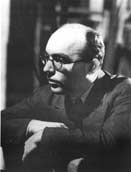Kurt Weill |
During the mid-twenties, the success of his works at international festivals and in the theatre placed him swiftly in the front ranks of his contemporaries. Der Protagonist (Dresden 1926), the opera buffa Der Zar lässt sich photographieren (Leipzig 1928) and his first collaboration with Brecht in Mahagonny Songspiel, a commission for the 1927 Baden-Baden Music Festival, gave him the partner he had been seeking to help carry out his personal ambition to reform the musical stage. His musical language had by this time developed away from his earlier influences (Wagner, Reger and Mahler) to a more sharply-etched 'modernist' idiom, cross-cut with the use of dance and jazz influences. In 1926, Weill had married the singer-actress Lotte Lenya and she played a major role in his gigantic success of August 1928, Die Dreigroschenoper, in which Brecht extensively adapted The Beggar's Opera, though Weill's music is totally original. The full-length opera Aufstieg und Fall der Stadt Mahagonny (Leipzig 1930) derived from the earlier Songspiel, and the school-opera Der Jasager and two radio cantatas Das Berliner Requiem and Der Lindberghtlug explored other media than the standard opera stage, but Brecht's restricted use of music for politico-polemic ends eventually made Weill look elsewhere and he collaborated with Caspar Neher and Georg Kaiser on Die Bürgschaft (1931) and Der Silbersee (1932) respectively. By 1933, the rise of Nazi propaganda (including riots at performances of his works) made emigration imperative for Weill and in March of that year he fled to Paris. Here he spent two and a half years, during which his 2nd Symphony was written, also a ballet-with-voices Die sieben Todsünden (his last major completed collaboration with Brecht), the musical play Marie Galante and a number of cabaret chansons. He worked during this period on a large oratorio-like score for Franz Werfel's play Der Weg der Verheissung and it was his collaboration on its production in America by Max Reinhardt that took him there in September 1935, Once in America, he realised that there, and no longer in Europe, was the chance for working with leading writers which he had always valued so highly, and he turned to the Broadway stage (and politically-committed theatre) with Johnny Johnson (1936). During the next decade, Broadway was enriched by Weill's partnerships with playwrights of the stature of Maxwell Anderson (with Knickerbocker Holiday in 1938, and Lost in the Stars in 1949), Moss Hart and Ira Gershwin (Lady in the Dark, 1941), Ogden Nash and S.J. Perelman (One Touch of Venus, 1948), Elmer Rice (Street Scene, 1947) and Alan Jay Lerner (Love Life, 1948). Although he had divorced Lotte Lenya when he left Germany, they travelled to America together and re-married in January 1937. He became an American citizen in 1943. His tragically early death in April 1950 came at a time when his "German" works were beginning to be re-discovered. Yet, the resulting dichotomy of the "two Weills" remains for posterity to resolve. Only now, forty years later, are we coming to grips with the remarkable range and endlessly fascinating variety of his works, which nevertheless all carry his unmistakable stylistic signature. Abbreviated version of the biography contained in KURT WEILL: A GUIDE TO HIS WORKS, published by the Kurt Weill Foundation of Music, Inc. New York, and reproduced by kind permission.
|
 Born on 2 March 1900, the son of
a cantor in Dessau, Kurt Weill displayed musical talent early; by the
time he was twelve, he was composing and during his teens he was accompanying
singers from the Dessau Court Opera and mounting concerts. He enrolled
at the Berlin Musikhochschule and studied first under Humperdink (which
he found stifling) and then, after a year as a theatre conductor, under
Busoni. He lived by playing the organ in a synagogue, the piano in a tavern,
by tutoring in music theory (including Claudio Arrau) and by becoming
a music critic in the young medium of wireless.
Born on 2 March 1900, the son of
a cantor in Dessau, Kurt Weill displayed musical talent early; by the
time he was twelve, he was composing and during his teens he was accompanying
singers from the Dessau Court Opera and mounting concerts. He enrolled
at the Berlin Musikhochschule and studied first under Humperdink (which
he found stifling) and then, after a year as a theatre conductor, under
Busoni. He lived by playing the organ in a synagogue, the piano in a tavern,
by tutoring in music theory (including Claudio Arrau) and by becoming
a music critic in the young medium of wireless.